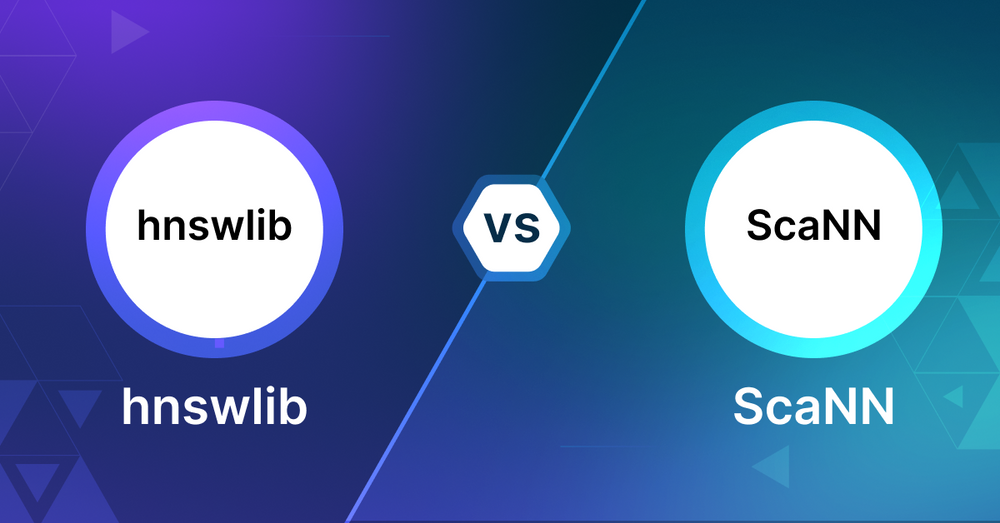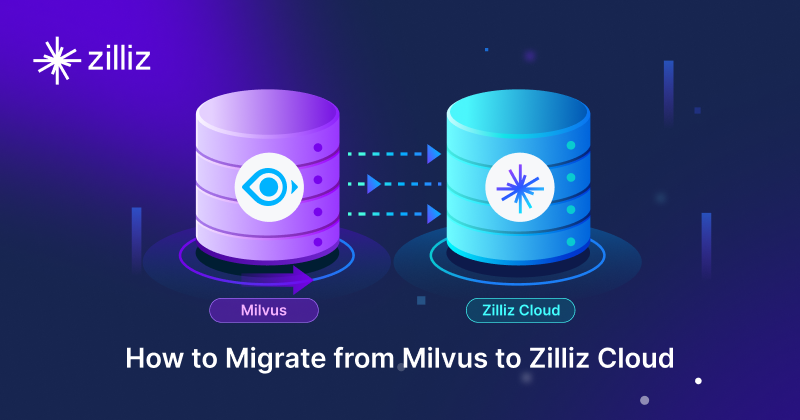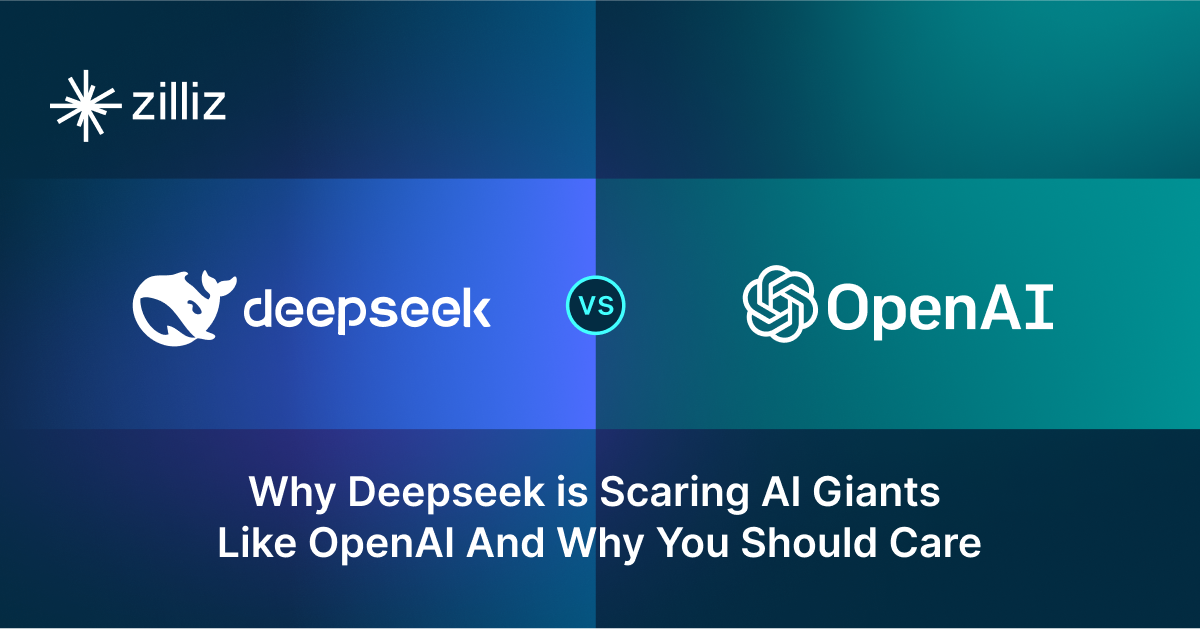HNSWlib vs ScaNN: Choosing the Right Vector Search Tool for Your Application

As AI-driven applications continue to grow, the need for fast and scalable vector search tools has become essential. Vector search is a key element in recommendation systems, image retrieval, natural language processing (NLP), and other fields where finding similarities between high-dimensional data is critical. Among the many tools available for vector search, HNSWlib and ScaNN are two widely used options, each offering distinct advantages.
In this article, we’ll compare HNSWlib and ScaNN, focusing on their features, search methodologies, scalability, and use cases to help you decide which one is better suited for your needs.
What is Vector Search?
Before diving into the specifics of HNSWlib and ScaNN, it's essential to understand vector search. Simply put, Vector search, or vector similarity search, finds the closest vectors (data points) in a high-dimensional space to a given query vector. These vectors are often generated by machine learning models to capture the essence of the unstructured data (e.g., the meaning of a sentence or the features of an image).
Unlike traditional databases, where searches are based on exact matches or filtering, vector search focuses on similarity. The goal is to find vectors that are "close" to each other based on a distance metric (such as Euclidean distance or cosine similarity). For instance, vectors can represent words or sentences in natural language processing (NLP), and vector search helps find the most semantically similar words or texts. In recommendation systems, vector search identifies items closest to a user's preferences. Vector searches also play a crucial part in retrieval augmented generation (RAG), a technique that augments the output of large language models (LLMs) by providing them with extra contextual information.
There are many solutions available on the market for performing vector searches, including:
- Vector search libraries such as HNSWlib and ScaNN.
- Purpose-built vector databases such as Milvus, Zilliz Cloud (fully managed Milvus)
- Lightweight vector databases such as Chroma and Milvus Lite.
- Traditional databases with vector search add-ons
What is HNSWlib? An Overview
HNSWlib (Hierarchical Navigable Small World) is an open-source library that implements a fast approximate nearest neighbor search (ANNS) algorithm based on small-world graphs. This method allows for highly efficient searches in high-dimensional vector spaces. HNSWlib is popular for its balance between search speed and memory efficiency, making it a powerful tool for applications where fast searches are crucial.
HNSWlib Core Features and Strengths
One of the main advantages of HNSWlib is its graph-based approach to vector search. The library builds a graph where each node represents a vector, and the connections between nodes represent proximity to other vectors. When a query is made, the search algorithm navigates through the graph to find the most similar vectors.
- In-Memory Search: HNSWlib performs all its operations in memory, which ensures low-latency searches. This makes it an excellent choice for real-time applications.
- Efficient Search: The hierarchical graph structure allows for fast approximate nearest neighbor searches, even with large datasets.
- Ease of Use: HNSWlib is simple to set up and doesn’t require much configuration. It’s designed to work out of the box with minimal tuning, making it a great choice for developers who want a fast and easy-to-use vector search tool.
How HNSWlib Integrates Vector Search
HNSWlib’s vector search functionality revolves around its graph-based approach. The library constructs a hierarchical graph, and queries are processed by traversing this graph, jumping between nodes to find vectors that are close to the query. This method reduces the number of comparisons needed, speeding up the search process. The trade-off, however, is that HNSWlib is an approximate nearest neighbor search tool, meaning it may not always return the exact nearest neighbors, but it does so with minimal delay.
What is ScaNN? An Overview
ScaNN (Scalable Nearest Neighbors) is a vector search library developed by Google. It is designed to handle large-scale datasets with high efficiency and speed. It is a powerful tool for applications that need fast vector searches, such as in recommendation engines, image search, and NLP tasks. ScaNN is optimized for approximate nearest neighbor search (ANNS), balancing speed and accuracy.
ScaNN Core Features and Strengths
ScaNN is built to handle large datasets efficiently, even those containing billions of vectors. It achieves this through a combination of techniques, including partitioning, quantization, and asymmetric hashing. These methods help reduce search space and improve memory usage and search speed.
- Partitioning and Quantization: ScaNN divides the dataset into smaller clusters and compresses the vectors to reduce memory usage, which speeds up searches without sacrificing too much accuracy.
- Customizable Trade-off: ScaNN allows users to control the balance between search speed and accuracy, making it flexible enough to be tailored to various use cases.
- TensorFlow Integration: ScaNN integrates seamlessly with TensorFlow, making it easy to incorporate into machine learning workflows that use embeddings or vector representations.
How ScaNN Handles Vector Search
ScaNN focuses on approximate nearest neighbor search and uses techniques like partitioning and quantization to improve performance. By dividing the dataset into smaller partitions, ScaNN narrows down the search space, allowing for fast query processing. It also supports vector compression, which reduces memory usage, making ScaNN a good choice for applications that need to handle large-scale data efficiently.
Key Differences Between HNSWlib and ScaNN
While both HNSWlib and ScaNN are designed for fast, approximate nearest neighbor search, they differ in several ways, including their search methodologies, data handling approaches, scalability, and flexibility. Let’s explore these differences in detail.
Search Methodology
HNSWlib is based on a graph-based search algorithm. It builds a graph where each node represents a vector, and the search algorithm navigates through the graph to find the nearest neighbors. The hierarchical graph structure allows HNSWlib to quickly find approximate neighbors, minimizing the number of comparisons required. This method is particularly effective for in-memory searches where speed is critical.
ScaNN, on the other hand, uses a combination of partitioning and quantization to reduce the search space. ScaNN clusters the dataset into partitions, and searches are performed within the most relevant partitions. This allows ScaNN to handle very large datasets efficiently while maintaining a good balance between accuracy and speed. ScaNN’s focus on vector compression further enhances its scalability.
Data Handling
HNSWlib is designed to handle in-memory datasets, requiring the entire dataset to be loaded into RAM for searches. This approach ensures low-latency searches but limits scalability if your dataset is too large to fit into memory.
ScaNN is more flexible in terms of data handling. It uses vector compression and partitioning to reduce memory usage, allowing it to handle larger datasets more efficiently. While it operates primarily in memory, its compression techniques make it better suited for applications where memory is a constraint.
Scalability and Performance
In terms of scalability, ScaNN has the edge over HNSWlib. ScaNN’s partitioning and quantization techniques allow it to scale more effectively for very large datasets. It’s designed to handle billions of vectors while maintaining high search speeds, making it particularly well-suited for large-scale applications where the dataset size is a significant consideration.
HNSWlib performs well for mid-sized datasets but is limited by its in-memory operations. As the dataset grows, the memory requirements increase, which can be a limiting factor for scalability. However, for datasets that fit comfortably in memory, HNSWlib offers superior speed, making it ideal for real-time search applications.
Flexibility and Customization
ScaNN provides more customization options, particularly when it comes to balancing search speed and accuracy. Users can fine-tune the system to prioritize speed or accuracy based on the specific requirements of their application. This flexibility makes ScaNN more adaptable to a variety of use cases.
HNSWlib is less customizable but simpler to use. It’s designed to work efficiently out of the box, with minimal configuration required. This makes it a great option for developers who want a fast and easy-to-use solution without the need to fine-tune parameters.
Integration and Ecosystem
ScaNN is tightly integrated with TensorFlow, making it an ideal choice for machine learning applications that already rely on this framework. Its integration with TensorFlow simplifies the vector search process into machine learning workflows, particularly for tasks involving embeddings.
HNSWlib, while not as deeply integrated with machine learning frameworks as ScaNN, is a standalone library that can be easily integrated into Python-based applications. It’s widely used in a variety of industries, from recommendation engines to NLP applications, and its simple API makes it easy to incorporate into existing systems.
Ease of Use
HNSWlib is known for its simplicity. It’s easy to set up, requires minimal configuration, and works efficiently with default settings. This makes it a great choice for developers who need a straightforward, fast solution for vector search.
ScaNN, while also user-friendly, requires a bit more setup, particularly when fine-tuning the trade-offs between speed and accuracy. However, for developers working within the TensorFlow ecosystem, ScaNN’s ease of integration can streamline workflows.
Cost Considerations
In terms of cost, HNSWlib requires less hardware since it’s optimized for CPU-based searches and performs operations entirely in memory. However, the requirement for sufficient memory to hold the entire dataset can increase costs if the dataset is large.
ScaNN, with its focus on handling larger datasets efficiently, may require more computational resources, particularly in terms of memory. However, its ability to compress vectors and partition datasets can help reduce overall memory usage, potentially lowering infrastructure costs for large-scale applications.
Security Features
Neither HNSWlib nor ScaNN offers built-in security features like encryption or access control. Developers will need to implement their own security measures based on the specific requirements of their application, such as data encryption and user authentication. If you have higher security and availability requirements, you can choose a purpose-built vector database like Milvus with much more advanced and enterprise-level features than ScaNN and HNSWlib.
When to Choose HNSWlib
HNSWlib is the right choice if you need a fast, in-memory search solution for mid-sized datasets. Its graph-based approach provides low-latency searches, making it perfect for real-time applications where search speed is critical. HNSWlib is also simpler to set up and doesn’t require much customization, making it ideal for developers who want a quick and efficient solution without the need for extensive fine-tuning.
Use HNSWlib if:
- You’re working with mid-sized datasets that fit comfortably in memory.
- You need real-time search capabilities with minimal latency.
- You prefer a simple setup with minimal configuration.
When to Choose ScaNN
ScaNN is better if you’re working with large datasets and need a highly efficient, scalable solution. Its ability to handle billions of vectors, combined with its partitioning and quantization techniques, makes it ideal for applications where speed and memory efficiency are essential. ScaNN is particularly well-suited for machine learning workflows that use TensorFlow and require fast, approximate nearest neighbor search.
Use ScaNN if:
- You are working with large-scale datasets.
- Your application requires integration with TensorFlow.
- You need a balance between search speed and accuracy.
Comparing Vector Search Libraries and Purpose-built Vector Databases
Both vector search libraries like HNSWlib and ScaNN and purpose-built vector databases like Milvus aim to solve the similarity search problem for high-dimensional vector data, but they serve different roles.
Vector search libraries focus solely on the task of efficient nearest neighbor search. They offer lightweight, fast solutions for finding vectors similar to a query vector. They are often used in smaller, single-node environments or for applications with static or moderately sized datasets. However, they generally lack features for managing dynamic data, providing persistence, or scaling across distributed systems. Developers using these libraries typically need to manually handle data management, updates, and scaling.
On the other hand, purpose-built vector databases like Milvus and Zilliz Cloud (the managed Milvus) are comprehensive systems designed for large-scale vector data management. These databases go beyond simple vector search, offering features like persistent storage, real-time updates, distributed architecture, and advanced querying capabilities. They support dynamic datasets and can easily handle real-time applications where data is frequently updated. Additionally, vector databases often include integrated support for combining vector searches with traditional filtering and metadata queries, making them ideal for production environments requiring scalability, high availability, and more complex search functionalities.
- Check out the latest new features and enhancements of Zilliz Cloud: Zilliz Cloud Update: Migration Services, Fivetran Connectors, Multi-replicas, and More
When to Choose Each Vector Search Solution
Choose Vector Search Libraries if:
- You have a small to medium-sized, relatively static dataset.
- You prefer full control over indexing and search algorithms.
- You're embedding search in an existing system and can manage the infrastructure.
Choose Purpose-Built Vector Databases if:
- You need to scale to billions of vectors across distributed systems.
- Your dataset changes frequently, requiring real-time updates.
- You prefer managed solutions that handle storage, scaling, and query optimizations for you.
In summary, vector search libraries are best suited for simpler, smaller-scale use cases where speed and memory efficiency are priorities, but operational complexity is minimal. Purpose-built vector databases, by contrast, are designed for large-scale, production-grade systems that demand dynamic data handling, scalability, and ease of use, often providing significant operational benefits for developers managing complex applications.
Evaluating and Comparing Any Vector Search Solutions
OK, now we've learned the difference between different vector search solutions. The following questions are: how do you ensure your search algorithm returns accurate results and does so at lightning speed? How do you evaluate the effectiveness of different ANN algorithms, especially at scale?
To answer these questions, we need a benchmarking tool. Many such tools are available, and two emerge as the most efficient: ANN benchmarks and VectorDBBench.
ANN benchmarks
ANN Benchmarks (Approximate Nearest Neighbor Benchmarks) is an open-source project designed to evaluate and compare the performance of various approximate nearest neighbor (ANN) algorithms. It provides a standardized framework for benchmarking different algorithms on tasks such as high-dimensional vector search, allowing developers and researchers to measure metrics like search speed, accuracy, and memory usage across various datasets. By using ANN-Benchmarks, you can assess the trade-offs between speed and precision for algorithms like those found in libraries such as Faiss, Annoy, HNSWlib, and others, making it a valuable tool for understanding which algorithms perform best for specific applications.
ANN Benchmarks GitHub repository: https://github.com/erikbern/ann-benchmarks
ANN Benchmarks Website: https://ann-benchmarks.com/
VectorDBBench: an open source benchmarking tool
VectorDBBench is an open-source benchmarking tool designed for users who require high-performance data storage and retrieval systems, particularly vector databases. This tool allows users to test and compare the performance of different vector database systems such as Milvus and Zilliz Cloud (the managed Milvus) using their own datasets, and determine the most suitable one for their use cases. VectorDBBench is written in Python and licensed under the MIT open-source license, meaning anyone can freely use, modify, and distribute it.
VectorDBBench GitHub repository: https://github.com/zilliztech/VectorDBBench
Take a quick look at the performance of mainstream vector databases on the VectorDBBench Leaderboard.
Techniques & Insights on VectorDB Evaluation:
Further Resources about VectorDB, GenAI, and ML
- What is Vector Search?
- What is HNSWlib? An Overview
- What is ScaNN? An Overview
- Key Differences Between HNSWlib and ScaNN
- When to Choose HNSWlib
- When to Choose ScaNN
- Comparing Vector Search Libraries and Purpose-built Vector Databases
- Evaluating and Comparing Any Vector Search Solutions
- Further Resources about VectorDB, GenAI, and ML
Content
Start Free, Scale Easily
Try the fully-managed vector database built for your GenAI applications.
Try Zilliz Cloud for FreeKeep Reading

Why and How to Migrate from Self-Hosted Milvus to Zilliz Cloud
A simple, step-by-step guide to migrating from Milvus to Zilliz Cloud. Learn both endpoint and backup methods for a smooth, scalable vector database migration.

Why Deepseek is Waking up AI Giants Like OpenAI And Why You Should Care
Discover how DeepSeek R1's open-source AI model with superior reasoning capabilities and lower costs is disrupting the AI landscape and challenging tech giants like OpenAI.

Vector Databases vs. In-Memory Databases
Use a vector database for AI-powered similarity search; use an in-memory database for ultra-low latency and high-throughput data access.
The Definitive Guide to Choosing a Vector Database
Overwhelmed by all the options? Learn key features to look for & how to evaluate with your own data. Choose with confidence.